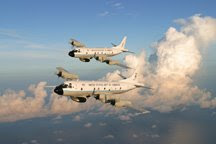 T.S. Colin came along for part of one day early this week. I believe that a forecaster, in a weak moment in the wee hours of the morning, made an error in judgment in upgrading the depression to a named storm. It was quickly downgraded back to a depression later that day. It's currently a tropical wave NNE of Puerto Rico but could re-intensify into a T.S. as it moves off to the north. The latest visible
T.S. Colin came along for part of one day early this week. I believe that a forecaster, in a weak moment in the wee hours of the morning, made an error in judgment in upgrading the depression to a named storm. It was quickly downgraded back to a depression later that day. It's currently a tropical wave NNE of Puerto Rico but could re-intensify into a T.S. as it moves off to the north. The latest visible  satellite image shows it getting its act together again. No worries for the U.S., though. As the forecast tracks indicate, Colin will be racing off to the NE in a few days time. Our friends in St. John's Newfoundland may bet a piece of the action, but they are hardy souls who thrive on bad weather and moose meat.
satellite image shows it getting its act together again. No worries for the U.S., though. As the forecast tracks indicate, Colin will be racing off to the NE in a few days time. Our friends in St. John's Newfoundland may bet a piece of the action, but they are hardy souls who thrive on bad weather and moose meat.Not much else going on in the tropics. Don't be fooled, though. It's only early in August. In 2004 we didn't have our first hurricane until the 1st of August, and it turned out to be one of the busiest seasons on record. Conditions are right in the tropics, so hold on to your hat. The forecasting group at Colorado State Univ. are sticking with their earlier predictions of 18 named storms and 10 hurricanes. So far the record is 3 and 1, which means we have a lot more in the pipeline.
Had a nice four-day vacation in Wisconsin last week. It was supposed to have been a five- day vacation at the Maloney cottage on Green Bay and two in the air going and coming. Turned out to be 4 and 3 as out of four flights, two were cancelled and the other two were late by as much as three hours.
day vacation at the Maloney cottage on Green Bay and two in the air going and coming. Turned out to be 4 and 3 as out of four flights, two were cancelled and the other two were late by as much as three hours.  But, we were blessed with great weather, nice people and a lot of fun. No complaints - except to Delta Air Lines.
But, we were blessed with great weather, nice people and a lot of fun. No complaints - except to Delta Air Lines.
 day vacation at the Maloney cottage on Green Bay and two in the air going and coming. Turned out to be 4 and 3 as out of four flights, two were cancelled and the other two were late by as much as three hours.
day vacation at the Maloney cottage on Green Bay and two in the air going and coming. Turned out to be 4 and 3 as out of four flights, two were cancelled and the other two were late by as much as three hours.  But, we were blessed with great weather, nice people and a lot of fun. No complaints - except to Delta Air Lines.
But, we were blessed with great weather, nice people and a lot of fun. No complaints - except to Delta Air Lines.




































